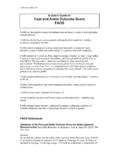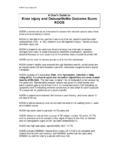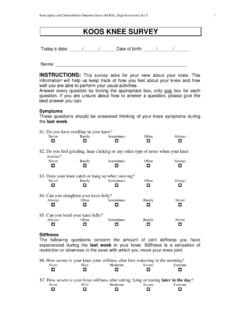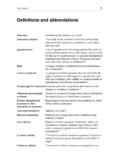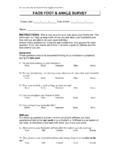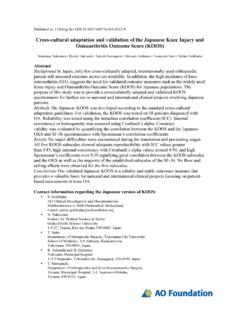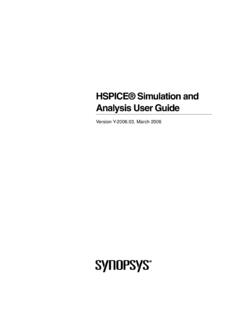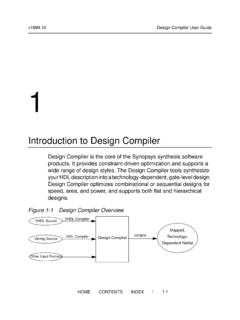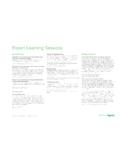Transcription of The 2012 User's Guide to: Knee injury and …
1 KOOS User's Guide Updated August 2012 1. The 2012 User's Guide to: knee injury and osteoarthritis outcome score KOOS. This Guide is intended to serve as an introduction for clinicians and researchers wishing to use the KOOS. For more detailed information, please refer to the FAQ. section at or to the scientific papers referred to in the different sections in that website. KOOS scoring instructions are available in a separate document from the website The KOOS questionnaire was developed in the 1990s as an instrument to assess the patient's opinion about their knee and associated problems. Since the first publication in 1998, the psychometric properties of the KOOS have been assessed in more than twenty individual studies from all over the world. Furthermore, KOOS has been evaluated and compared to other instruments in several reviews [1-8].
2 KOOS is widely used for research purposes in clinical trials, large-scale databases and registries. KOOS is also extensively used for clinical purposes. In the clinic, KOOS is used to monitor groups and individuals over time. Due to its comprehensiveness, when the questionnaire is completed prior to a consultation, it can be used to Guide the consultation as to the symptoms and difficulties experienced by the patient. KOOS is intended to be used for knee injury that can subsequently result in post- traumatic osteoarthritis (OA); ACL (anterior cruciate ligament) injury , meniscus injury , chondral injury , etc. KOOS is also used in knee OA. An advantage of the KOOS is the inclusion of two different subscales of physical function relating to daily life, and sport and recreation. This enhances the instrument's validity for patients with a wide range of current and expected physical activity levels.
3 KOOS is intended to be used over short- and long-term time intervals; to assess changes from week to week induced by treatment (medication, operation, physical therapy) or over years following a primary injury or OA. KOOS can be used in research to assess groups and to monitor individuals. KOOS' content validity was based upon a literature search, a pilot study and an expert panel (from US and Sweden) consisting of patients, orthopedic surgeons and physical therapists. KOOS consists of 5 subscales; Pain, other Symptoms, Activites of Daily Living (ADL), Sport and Recreation Function (Sport/Rec) and knee -related Quality of Life (QOL). The previous week is the time period considered when answering the questions. Standardized answer options are given (5 Likert boxes) and each question is assigned a score from 0 to 4.
4 A normalized score (100 indicating no symptoms and 0 indicating extreme symptoms) is calculated for each subscale (KOOS scoring KOOS User's Guide Updated August 2012 2. instructions are available in a separate document from ). A total score has not been validated and is not recommended. For the purpose of an RCT, KOOS. subscale scores can be aggregated and averaged as the primary outcome . The five individual KOOS subscale scores are then given as secondary outcomes to enable clinical interpretation. Please see FAQ for further information on this procedure. The results of the 5 subscales can be plotted as an outcome profile (order of subscales from left to right: Pain, Symptoms, ADL, Sport/Rec and QOL), preferably in a graph with scores from 0-100 on the y-axis and the five subscales on the x-axis (an example is presented later in this User's Guide , under the heading of KOOS Profile).
5 KOOS is patient-administered, the format is user -friendly, and takes about 10. minutes to complete. KOOS is self-explanatory and can be administered in the waiting room or used as a postal or electronic survey. Paper-based and computerized versions are comparable with regard to psychometrics [9]. KOOS is in the public domain and is free of charge. No licensing or permission to use KOOS or the other questionnaires available from is required. KOOS has been used in patients 13-79 years of age. A newly developed KOOS child version for children aged 9-12 years is available from KOOS reference values are available from several groups including a population- based sample [10], a group of active soccer players [11], a group of healthy female soccer players [12], male and female patients following ACL reconstruction [13], and from another population-based group of 50 participants (mean 53 years, 37-79) who had no previous and no current clinical signs of injury to the ACL or menisci and no radiographic signs of OA [14].
6 KOOS has high test-retest reliability. In patients with knee injury , ICCs for the Pain subscale range from , the Symptoms subscale from , the ADL. subscale from , the Sport/Rec subscale from and the QOL. subscale from In patients with knee OA, ICCs for the Pain subscale range from , the Symptoms subscale from , the ADL subscale from , the Sport/Rec subscale from and the QOL subscale from [3]. The Minimal Detectable Changes in patients with knee injury were for Pain , for Symptoms , for ADL 7-8, for Sport/Rec , and for QOL The Minimal Detectable Changes in patients with knee OA were for Pain , for Symptoms , for ADL , for Sport/Rec , and for QOL [3]. The Minimal Important Change (MIC) is currently suggested to be 8-10. However, the current understanding is that MIC is dependent on factors such as patient group, intervention and time to follow-up.
7 Thus most likely there is no such thing as one MIC. value for an instrument. Research is ongoing; please refer to FAQ on the website for more complete information. KOOS includes WOMAC osteoarthritis Index LK [15] in its complete and original format (with permission), and WOMAC scores can be calculated (how to KOOS User's Guide Updated August 2012 3. calculate WOMAC scores is presented in the document KOOS scoring , available from ). WOMAC is valid for elderly subjects with knee OA. KOOS subscales Sport and Recreation function' and Quality of Life' were more sensitive and discriminative than the WOMAC subscales Pain', Stiffness', and Function' when studied in subjects meniscectomized 21 years prior and with definite radiographic signs of OA (mean 57 years, range 38-76) compared to age- and gender-matched controls [16].
8 KOOS' convergent and divergent construct validity has been determined in multiple studies in comparison to several instruments including the different subscales of SF-36 and the Lysholm knee scoring scale [3]. KOOS is responsive to change following non-surgical and surgical interventions. KOOS' responsiveness has been reported following surgical procedures including ACL reconstruction, meniscectomy, cartilage repair procedures, tibial osteotomy, total knee replacement, physical therapy, as well as nutritional and pharmaceutical interventions. Following orthopedic surgery, including total knee replacement, QOL is usually the most responsive subscale [8]. KOOS is currently available in the original English and Swedish versions (which were developed concurrently) and the following translated versions: Austrian- German, Chinese, Croatian, Czech, Danish, Dutch, Estonian, French, German, Hindi (India), Italian, Japanese, Korean, Latvian, Lithuanian, Norwegian, Persian, Polish, Portuguese, Russian, Singapore English, Slovakian, Slovenian, Spanish (Peru), Spanish (US), Thai, Turkish, and Ukrainian.
9 Translation work is currently underway with: Kannada (India), Tamil (India), Telugu (India), Malayalam (India), Bengali (India), Gujarati (India), Arabic (Saudi Arabia), Arabic (Egypt), Vietnamese, Brazilian Portuguese and Romanian. New language versions are available at as they are developed. Questions? If you have any queries, first contact the KOOS web manager. The KOOS web manager also handles requests to translate the KOOS for use in other countries: Email: If necessary, the KOOS web manager will contact the developer: Professor Ewa Roos, Department of Sports Science and Clinical Biomechanics, University of Southern Denmark, Odense, Denmark Email: KOOS User's Guide Updated August 2012 4. KOOS Profile To visualize differences in the five different KOOS subscores and change between different administrations of the KOOS ( pre-treatment to post-treatment), KOOS.
10 Profiles can be plotted. The example from Nilsdotter et al. [17] shows KOOS profiles prior to and at three time points following total knee replacement (TKR). REFERENCES. 1. Roos EM, Lohmander LS. knee injury and osteoarthritis outcome score (KOOS): from joint injury to osteoarthritis . Health Qual Life Outcomes 2003;1:64. 2. Rodriguez-Merchan EC. knee instruments and rating scales designed to measure outcomes. Journal of orthopaedics and traumatology : official journal of the Italian Society of Orthopaedics and Traumatology 2012;13:1-6. 3. Collins NJ, Misra D, Felson DT, Crossley KM, Roos EM. Measures of knee function: International knee Documentation Committee (IKDC) Subjective knee Evaluation Form, knee injury and osteoarthritis outcome score (KOOS), knee injury and osteoarthritis outcome score Physical Function Short Form (KOOS-PS), knee outcome Survey Activities of Daily Living Scale (KOS-ADL), Lysholm knee Scoring Scale, Oxford knee score (OKS), Western Ontario and McMaster Universities osteoarthritis Index (WOMAC), Activity Rating Scale (ARS), and Tegner Activity score (TAS).
